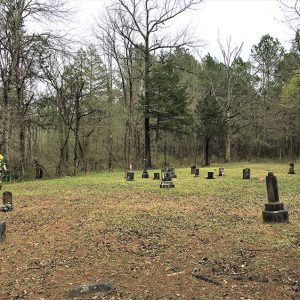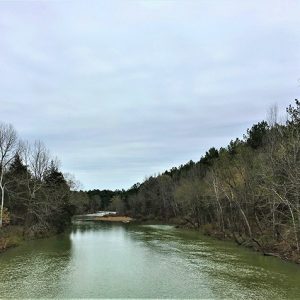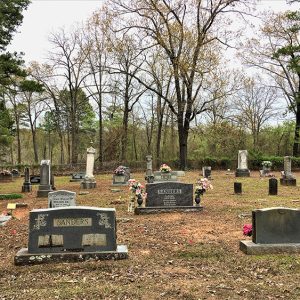calsfoundation@cals.org
Cedar Creek (Scott County)
The unincorporated community of Cedar Creek is located along Highway 28 in eastern Scott County. The town was established in 1852 near the Fourche La Fave River between two of its tributaries. Originally, Cedar Creek was broken up into two different communities that were about three miles apart: Little Cedar and Big Cedar. The communities were named after the two tributaries of the Fourche La Fave River: Little Cedar Creek and Big Cedar Creek; to avoid confusion, the residents simply began calling the area Cedar Creek.
Before European exploration, Cedar Creek was a wilderness containing various species of wildlife, some of which no longer inhabit the area. Early inhabitants included peoples of the Archaic, Woodland, and Mississippian periods. Several hundred years before European contact, the Caddo tribe made the area along the Fourche La Fave River its home. There are numerous burial mounds and archaeological sites located along the river near Cedar Creek. Throughout the late seventeenth and early eighteenth centuries, it is likely that French trappers and traders traversed the Fourche La Fave River and other prominent bodies of water in the area.
A post office for early settlers of the area was opened on November 16, 1852. It was initially operated by George P. Ward, followed by John W. Cole in 1853, James Gibson in 1854, and Virginia A. Sanders in 1870.
Early settlers of Cedar Creek came to the area in search of opportunity. Farming was common practice for many of these early settlers. There were also early mining efforts in Cedar Creek due to exposed veins of lead and zinc scattered throughout the valley. However, settlers found that mining the subterranean minerals proved impractical.
Homesteaders, squatters, renters, and drifters made their way to the community as it grew. One of the early churches, known as “Church in the Wildwood,” functioned as the local school. The church/schoolhouse was located on the west bank of Little Cedar Creek. Missionary Baptist, Free Will Baptist, Church of God, and Nazarene congregations all held joint meetings at the church. A store run by Joe Henry Clymer was located near the church. Cedar Creek Cemetery was established circa 1871. Another cemetery used by residents of Cedar Creek is located near the banks of Big Cedar Creek. Big Cedar Cemetery was established in 1898. It was formerly a private cemetery belonging to the Defoor family. Even though the cemetery was private, that family allowed several infants from Forrester (Scott County) to be buried there in the early twentieth century.
In May 1882, the Scott County Courthouse burned, destroying all records that defined the boundaries of the various school districts that had been established throughout the county. Several months later, in August, the county court re-established the boundaries of the fifty-six school districts active in the county, including Cedar School District (Number 4).
The Cedar School District was re-established in January 1884 when W. A. D. Roberts petitioned the county court not to sell liquor within three miles of the school. The school was also known as Arrington’s School, named for William Arrington, who made the initial entry on the land where the school was located. The school district was later named Big Cedar when Little Cedar School District (Number 23) was established in 1892. The Little Cedar School was also called Worsham’s School, named for John L. Worsham, who made the initial entry on the land where the school house was located.
By 1907, Cedar Creek had a connection with the Waldron Telephone Company. A ball field was located in front of the school in an open field. During recess, the children would often wade around in the waters of the creek or play on the ball field. From 1916 to 1928, Cedar Creek had two cotton gins. One cotton gin, owned and operated by Will Clymer and George Crutchfield, was located to the north of the first store. Clymer also owned a sawmill, which provided the lumber for early housing. The second cotton gin was owned by A. M. Abbott. Two stores were located in Cedar Creek in the early twentieth century. One was a union store operated by a Mr. Easley. The second was a general store owned by a Mr. Abbott. In 1919, the post office was moved from Little Cedar to Big Cedar. In 1926, Little Cedar School District erected a new school house. It was later used as the community center in Cedar Creek. Big Cedar School District was changed to Forester (Scott County) in 1929 with the establishment of the Caddo River Lumber Company. Sometime between 1930 and 1940, Little Cedar School District was consolidated with Parks School District. In the early 1930s, the Cedar Creek Post Office was moved to the growing town of Forrester. A year later in 1931, the Kansas City Southern Railroad built a twenty-three-mile extension from Waldron (Scott County) to Forrester to service the Caddo River Lumber Company. The railroad passed through Cedar Creek, creating job opportunities and growth in the area.
During World War II, several members of the Cedar Creek community served in the military. In 1953, the Cedar Creek Post Office was reestablished by Hellen Nelson after the closure of the Caddo River Lumber Company and abandonment of Forrester. The post office was in operation until 1973. The closure of the lumber company caused a decline of industry and population in Cedar Creek. Eventually, the school was consolidated with the Waldron School District and businesses were closed.
The population of Cedar Creek was greatly reduced by the twenty-first century, although a community remained. The Cedar Creek Community Church continues to operate, and the building is also used as a community center and voting center. Fishing and hunting are common recreational activities within the Cedar Creek community, which is surrounded by thousands of acres of the Ouachita National Forest.
For additional information:
Cate, Michael. History of Scott County, Arkansas. Dallas, TX: Curtis Media Corporation, 1991.
Echoes: The Scott County Historical and Genealogical Society Quarterly. Waldron, AR: Scott County Historical and Genealogical Society (1986–).
Goodner, Charles. Scott County in Retrospect. Mansfield, AR: Frank Boyd, 1976.
Goodner, Norman. A History of Scott County, Arkansas. Siloam Springs, AR: Bar D Press, 1941.
McCutcheon, Henry Grady. History of Scott County, Arkansas. Little Rock: H. G. Pugh and Company, 1922.
Ty Richardson
Richardson Preservation Consulting
 Big Cedar Cemetery
Big Cedar Cemetery  Big Cedar Creek
Big Cedar Creek  Cedar Creek Cemetery
Cedar Creek Cemetery  Cedar Creek Community Church
Cedar Creek Community Church  Little Cedar Creek
Little Cedar Creek  Sanders Cemetery
Sanders Cemetery  Scott County Map
Scott County Map 




Comments
No comments on this entry yet.